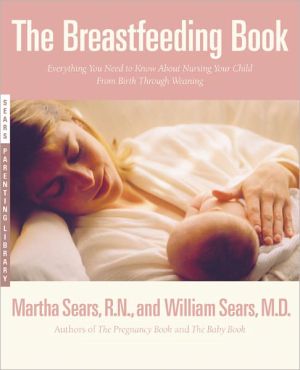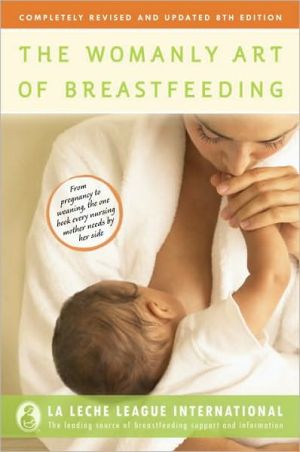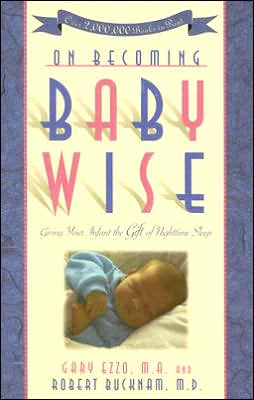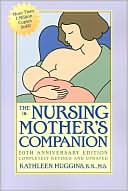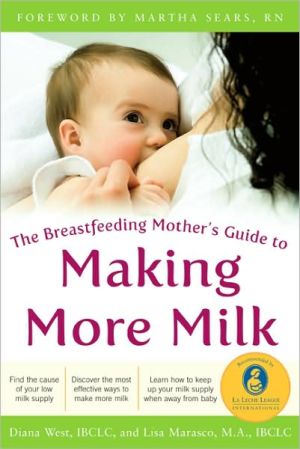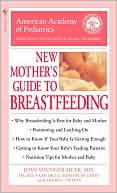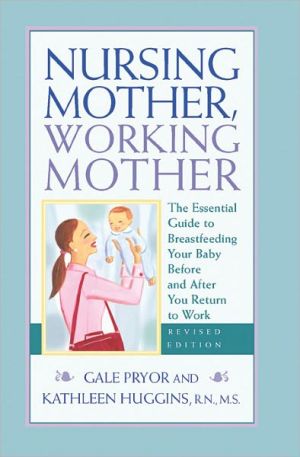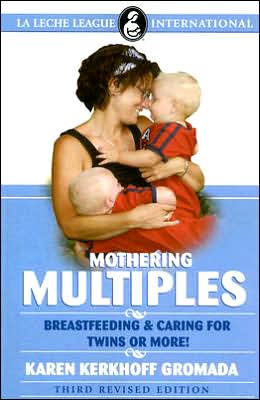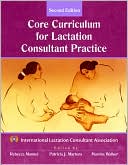Breastfeeding Book: Everything You Need to Know about Nursing Your Child from Birth Through Weaning
In recent years there has been a resurgence of interest in breastfeeding. Yet first-time mothers often lack the support and the knowledge they need. Many of the available books fail to address the practical challenges that confront many women (especially women who work outside the home) when they choose to breastfeed. For these women, The Breastfeeding Book is a godsend — with comprehensive, reassuring, authoritative information on:\ — how to get started, including tips for latching on\ —...
Search in google:
America's foremost baby and childcare experts take a realistic, contemporary approach to an age-old practice. Their encyclopedic guide to the art and science of breastfeeding enables all women to experience and enjoy one of nature's most rewarding relationships.
1\ Why Breast Is BestIN THE EARLY DAYS of learning to breastfeed, there may be times when you feel like tossing in the nursing bra and reaching for a bottle. You may be tempted to believe those advisers who suggest that formula feeding is easier or just as good. Or you may worry that you’re "not the type of mother" who succeeds at breastfeeding. Yet when you consider how breastfeeding benefits your baby, your family, and yourself, you will find the determination you need to overcome any obstacles and master the womanly art of breastfeeding. This chapter describes some of the innumerable ways that breastfeeding builds healthier brains, healthier bodies, and healthier families.\ What’s in it for Baby?\ How would you like to give your baby a gift that could raise his IQ by 10 points; cut medical bills; make your baby’s eyes, heart, intestines, and nearly every other organ work better; reduce the risk of life-shortening, debilitating diseases, such as diabetes; and help your baby avoid many of the common complaints of infancy, such as ear infections, tummy upsets, even diaper rash? What’s the magic gift that can do all these things? Your milk! You can make your baby’s life that much better simply by choosing to breastfeed.\ Brighter Brains Your baby’s brain grows more during infancy than at any other time, doubling its volume and reaching around 60 percent of its adult size by one year. As with every system in the body, the better you feed the brain, the better it can grow. Breast milk is the best food for developing brains, and a flurry of brainy breast-milk research is now confirming what nursing mothers have long suspected: breastfed babies are smarter. A headline in USA Today in 1992 boasted "Mother’s Milk: Food for Smarter Kids." Headlines such as this have renewed interest in the fact that breastfeeding is an important and often overlooked way to give a child, well, a head start. Scientific studies on the influence of breast milk on intellectual development conclude:\ \ * Children who were breastfed have IQ scores averaging 7 to 10 points higher than children who were formula fed.\ \ * The intellectual advantage gained from breastfeeding is greater the longer the baby is breastfed.\ \ * Intellectual differences between breastfed and formula-fed children that used to be attributed to the increased holding and interaction associated with breastfeeding and to the fact that mothers who breastfed were better educated and/or more child centered may be attributable to nutrients in breast milk that actually enhance brain growth.\ For years doctors told formula-feeding parents that by holding and interacting with their babies during feedings they could imitate breastfeeding, and their babies could then receive any intellectual or social benefits associated with breastfeeding. This was true to a point (it is better to hold the bottle and talk to your baby than to prop the bottle and walk away), but research is now showing that the smart stuff is in the milk, and it’s not just the mothering that matters.\ Smarter fats. What are these smart nutrients that are in mommy-made milk but not in milk from cows or the factory-made milk on the shelf at the store? One key ingredient is a brain-boosting fat called DHA (docosahexaenoic acid), an omega-3 fatty acid. DHA is one of several fats that have recently gotten a lot of attention as true health foods. DHA is considered a vital nutrient for the growth, development, and maintenance of brain tissue. Autopsy analysis of brain tissue from breastfed and formula-fed infants shows that the brains of breastfed babies have a higher concentration of DHA, and DHA levels are highest in babies who are breastfed the longest. This discovery is sending American formula manufacturers back to the drawing board, since at this writing infant formulas made in the United States do not contain DHA.\ Smarter sugars. The predominant sugar in breast milk is lactose, which the body breaks down into two simpler sugars, glucose and galactose. Galactose is a valuable nutrient for brain-tissue development. Anthropologists have demonstrated that the more intelligent species of mammals have greater amounts of lactose in their milk, and, not surprisingly, human milk contains one of the highest concentrations of lactose of any mammal’s milk. Cow’s milk and some cow’s-milk formulas contain lactose, but not as much as human milk does. Soy-based and other lactose-free formulas contain no lactose at all, only table sugar and corn syrup. As we’ll later discuss, lactose also promotes intestinal health.\ Smarter connections. Brain cells, called neurons, resemble miles of tangled electrical wires. During the period of rapid brain growth in the first two years of life, these neurons proliferate and connect with other neurons to make circuits throughout the brain. The more circuits a baby’s brain makes and the better the quality of these circuits, the smarter the baby. Every time a baby interacts with her caregivers, her brain makes new connections. Breastfed babies feed more often and are held more closely, with more skin-to-skin contact, so that each feeding is an opportunity to help the growing brain make the right connections, adding more circuits each time.\ Leaner Adult Bodies Breastfed infants become leaner adults. New research is discovering that leanness is associated with general health and well-being and with a lower risk of such diseases as heart disease, stroke, and diabetes. Studies have shown that children who were breastfed are less likely to be obese during adolescence, and that longer periods of breastfeeding greatly reduce the risk of being overweight later in childhood. Since overweight children are more likely to become overweight adults, preventing obesity in childhood is important. Lean means having just the right amount of body fat for an individual’s body type. In 1992 the DARLING (Davis Area Research on Lactation, Infant Nutrition, and Growth) study from the University of California at Davis compared the growth patterns of healthy breastfed and formula-fed infants and found that breastfed infants were leaner at one year of age than their formula-fed counterparts. Even plump breastfed babies gradually lose a lot of their adorable baby fat and eventually wind up leaner than their formula-fed peers.\ The satiety factor. Breastfed babies take smaller meals and eat more slowly. Eating patterns established in infancy reduce the tendency toward overeating later in life. Also, the high-fat milk that the baby receives toward the end of the feeding gives him a feeling of fullness. This and a satiety-producing hormone in the infant called cholecystokinin (CCK) condition the satisfied infant to stop eating. The breastfed baby himself controls how much he eats. You can’t urge him to finish up the last 1/2 ounce at the breast the way a parent might when giving a bottle. A breastfed baby learns to trust his own signals about how much he needs to eat and when.\ Better Eyes Not only does breast milk build brighter brains and healthier bodies, it’s valuable to baby’s vision, too. Studies comparing breastfed and formula-fed infants show that visual development (in particular visual acuity) is better in breastfed babies. This finding is particularly noticeable in premature infants. Again, the smart fat DHA may be one of the reasons. DHA is one of the prime structural components of the retina of the eye. As with all tissues, the better you feed it, the better it grows and functions. So the better you feed the retina, the better the vision — another reason why breastfed babies have a healthier "outlook" on life.\ Better Hearing Not only do breastfed infants think, grow, and see better, but they are also likely to hear better. Being able to hear well is necessary for language development, so this benefit of breastfeeding is very important. The reason breastfeeding promotes healthier hearing is that breastfed babies have fewer ear infections. Because breast milk is a human substance, babies are not allergic to it (but they can be allergic to cow’s-milk protein or other proteins in mother’s diet that piggyback into the breast milk). Allergies to soy or cow’s-milk proteins can cause fluid to build up behind the middle ear. This fluid not only dampens the vibration of the eardrum, decreasing hearing, it also provides a culture medium for bacteria and thus is a breeding ground for middle-ear infections. A history of frequent ear infections is common in children who are experiencing language delays.\ A Nicer Smile Pediatric dentists report that breastfed babies have better jaw alignment and are less likely to need orthodontic work. The sucking action used in breastfeeding involves more complex motions of the facial muscles and tongue. This improves the development of facial muscles, jawbones, and palate, leading to better jaw alignment and more room for teeth. The tongue-thrusting action bottle-fed infants use to control the flow of formula can contribute to malocclusion. Experienced pediatric dentists are often able to tell whether or not a baby was breastfed by the shape of the mouth and hard palate. Thus a baby’s breastfeeding efforts will be reflected in her face.\ Better Breathing Another benefit pediatric dentists have noticed is that breastfed babies develop a larger nasal space, which can lessen problems with snoring and sleep apnea later in life. Breastfed babies grow a rounder, U-shaped dental arch, whereas bottle-fed babies develop a narrower, higher, V-shaped arch, which not only contributes to the misalignment of teeth but also infringes on the nasal passages directly above the hard palate.\ Better Hearts Formula is cholesterol-free, but you won’t find formula manufacturers advertising this fact, even though you might expect a low-cholesterol diet to be good for babies — after all, many adults concerned with good nutrition try to limit their cholesterol intake. The cholesterol that is naturally present in cow’s milk is removed during the formula-manufacturing process and replaced with fats from plant sources. Cholesterol is not only present in breast milk in moderate amounts, but it is most likely there for a heart-healthy reason. Some heart researchers theorize that a breastfed baby’s liver learns to metabolize cholesterol better than a formula-fed infant’s does. Breastfed babies may then have lower blood-cholesterol levels as adults and may thus enjoy a lower risk of heart disease. Supporting the heart-healthy theory, studies show that although breastfed infants tend to have higher blood-cholesterol levels than formula-fed babies do, adults who were formula fed as infants tend to have higher blood-cholesterol levels and be more likely to have atherosclerotic plaque that can lead to heart attacks.\ Intestinal Health Breast milk is known as the "easy in—easy out" food. It’s easier to digest and makes easier-to-pass stools. In fact, breast milk contains enzymes that help babies digest their meals from the breast. Whey, the predominant protein in breast milk, forms an intestines-friendly, soft, easy-to-digest curd, unlike the rubbery, harder-to-digest casein curd formed in the digestion of most formulas. Tiny tummies like breast milk. It’s digested more quickly and is less likely to come back up. It doesn’t leave permanent stains on clothes, either.\ Breast milk is friendly to immature intestines. The cells of the intestinal lining are tightly packed together so that potential allergens cannot seep through into the bloodstream. But in the early months, the lining of the baby’s immature intestines is more like a sieve, allowing potential allergens to get through, which sets the infant and child up for allergies and infections. Breast milk contains a special protein called immunoglobulin A (IgA), which acts like a protective sealant in the digestive tract. Allergens and germs can’t get through as easily. Breast milk also contains a special substance called epidermal growth factor (EGF), which promotes the growth of the cells lining baby’s intestines as well as other surface cells, such as the cells of the skin.\ Breast milk produces caregiver-friendly stools. Unlike the stinky stools of a formula-fed baby, the stools of a breastfed infant have a not unpleasant buttermilk-like odor. In watching moms and dads change the diapers of a formula-fed baby, we have noticed that their facial expressions generally reflect reactions that range from mild aversion to downright disgust. Because the odor of breast-milk stools is not offensive to most parents, changing the diaper of a breastfed infant is not an unpleasant task (which is fortunate, because younger breastfed babies have several bowel movements a day). When the baby looks at the face of the diaper-changing caregiver and sees happiness rather than disgust, he picks up a good message about himself — perhaps a perk for building self-esteem.\ Breast milk helps better bugs live in the bowels. Intestines are healthier when you can keep the right bugs in the bowels, and that’s exactly what breast milk does. The intestines contain healthful as well as potentially harmful bacteria. The healthful bacteria, known as bifidus bacteria, do good things for the body in return for a warm place to live. They manufacture vitamins and nutrients and keep the harmful bacteria in check. Breast milk promotes the growth of healthful bacteria and inhibits the growth of harmful ones. The high level of lactose in breast milk particularly encourages the growth of the healthful resident bacteria Lactobacillus bifidus.\ Reduced Risk of Diabetes Breastfeeding, plus the delayed introduction of cow’s milk, reduces the risk of juvenile-onset diabetes. In addition, researchers have shown a lower insulin release in breastfed infants compared to infants fed formula. This preventive effect is particularly important for those who have a family history of diabetes.\ Immunities Your milk, like your blood, is a living substance. In the Koran, mother’s milk is called white blood. A drop of breast milk contains around one million white blood cells. These cells, called macrophages (big eaters), gobble up germs. Breast milk is also power-packed with immunoglobulin A (IgA), which coats the lining of baby’s immature intestines, helping prevent germs from leaking through. Colostrum, the "supermilk" you produce in the first few days, is especially rich in IgA, just at the time when a newborn is most susceptible to germs. Colostrum also contains higher amounts of white blood cells and other infection-fighting substances than does mature milk. Think of colostrom as your baby’s first important immunization.\ Filling the gap. Throughout the first six months, your baby’s ability to produce his own antibodies to germs is somewhat limited. His immune system doesn’t click into high gear until the second half of the first year. The maternal antibodies a baby receives through the placenta provide protection for a while, but antibodies gotten through the placenta are gradually used up during the first six months. Around six months of age, the influence of mother’s antibodies is waning and baby’s own antibodies are not yet at high levels. During this time, human milk’s germ-fighting antibodies and white blood cells provide what’s missing and protect baby from many of the germs in his environment.\ Mother continually updates baby’s immune protection. Because mother and baby are so close to each other, mother is exposed to the same environmental germs that a baby comes in contact with. The baby’s immune system is too immature to respond quickly to germs, so mother’s milk comes to the rescue. The mother’s more mature immune system makes antibodies to the germs to which she and baby have been exposed, and this army of infection fighters enters her milk and eventually her baby.\ Healthier Skin Many pediatricians who have developed a sharp eye and keen sense of touch over years of examining babies report that they can often tell by the look and feel of an infant’s skin whether or not the baby is breastfed or formula fed. The skin of a breastfed baby often has a softer, smoother feel. There is also less delineation between where the fat under the skin ends and the underlying muscle begins. The skin of formula-fed babies tends to be rougher, with dry, often sandpaper-like patches. Breastfed babies feel more solid. Researchers report that the subcutaneous fat in breastfed and formula-fed infants actually has a different composition.\ Better Taste Try the taste test. Sample a bit of breast milk (that is, if it’s currently available in your home) and compare it with formula (if that’s available in your home). Your tongue and nose will instantly tell you why babies prefer the real thing. Breast milk, because of its high lactose content, tastes fresh and sweet, unlike canned formula. Babies are born with a sweet tooth — the taste receptors for sweetness on their tongues are highly developed, so there’s a perfect match between the milk and infant gourmets. The more appealing, sweeter taste of breast milk may be why some breastfed infants refuse to take formula.\ Healthier Children and Adults Derrick and Patrice Jelliffe, pioneers in breastfeeding research, stated that breastfed infants are "biochemically different." This difference in body chemistry may be the reason they are healthier. There is evidence that breastfeeding protects babies against a great variety of illnesses, and in some cases this protection extends even beyond the time babies are nursing. While babies are breastfeeding, they have fewer and less serious respiratory infections, less diarrhea, and less vomiting. When breastfed babies do become ill, they are less likely to become dehydrated and less likely to need hospitalization. They enjoy protection from rotavirus (a type of respiratory infection), meningitis, infant botulism, and urinary tract infections. In developing countries, where there may not be safe water or good medical care, the protection that breastfeeding offers against cholera, various kinds of parasites, and other serious infections helps babies born in poverty to stay healthy. Researchers have also found that as children grow, having been breastfed as an infant is associated with a reduced risk of juvenile diabetes, childhood cancers, and digestive disorders, including ulcerative colitis and Crohn’s disease.\ What’s In It for Mother?\ By providing milk from your breasts, you’re guaranteeing the best nourishment for your baby. But breastfeeding is healthier not just for babies. It’s healthier for mothers, too. During breastfeeding, you give your baby ideal nourishment and nurturing, and as "payback" your baby, in effect, gives something back to you. You tap into a formula for mothering and nurturing your baby that is tested and true — as old as time itself. Breastfeeding will make it easier to care for your baby, and it will make it easier for you to know and understand your baby. It will affect the way you listen to your child, the way you communicate, and the way you respond for many years to come. This will make disciplining your child easier as she grows, and it will help you feel good about parenting.\ Faster Postpartum Recovery Breastfeeding helps your body recover from pregnancy more quickly. The baby’s sucking stimulates the release of the hormone oxytocin, which causes your uterus to contract and return more quickly to its prepregnant size. This hormone is a natural version of the synthetic one (pitocin) that obstetricians often give women immediately after birth to help contract the uterus and expel the placenta.\ Faster Weight Loss When compared with formula-feeding moms, breastfeeding mothers have an easier time losing weight postpartum. Making milk uses up fat stores from pregnancy. In one study, breastfeeding moms showed more fat loss and larger reductions in hip circumference by one month postpartum than nonbreastfeeding moms. In another study, breastfeeding women tended to lose more weight from three to six months postpartum than formula-feeding mothers did, even though the breastfeeding moms were consuming more calories.\ Hormonal Health Lactation is a natural part of a woman’s reproductive cycle, along with ovulation, menstruation, pregnancy, and childbirth. Good things happen throughout your body when baby sucks at your breast. The hormones released by sucking (prolactin and oxytocin) influence the overall balance of many of your other hormones and keep estrogen levels low, which may affect the development of certain cancers. Mothers report that breastfeeding is a pleasant, sensual experience. They enjoy the closeness, the skin contact with the baby, and pleasurable feelings from the nipple stimulation. These good feelings may originate in part with the hormone oxytocin, which is released during breastfeeding to stimulate the milk-ejection reflex. Oxytocin is released also during childbirth and during sexual intercourse. It acts like a bonding hormone; the good feelings it creates during important interpersonal acts like breastfeeding and sex help to build the strong human relationships that nurture babies and keep families together.\ Relaxation Not only does breastfeeding benefit mother’s body, it helps mother’s mind, too. The same hormones that help make milk help a mother feel peaceful. When mothers sit down to breastfeed, they may find themselves drifting off to sleep. If they’ve been feeling stressed or harried, breastfeeding brings a sense of contentment and relaxation. This may be prolactin at work, since prolactin is known to be one of the body’s stress-fighting hormones, and research has shown that breastfeeding mothers are more tolerant of stress. There is also a sleep-inducing protein in breast milk that may help baby into dreamland. When you watch a breastfeeding pair, you will notice how as the feeding progresses, mother mellows and baby drifts peacefully to sleep, as if both have been given a natural tranquilizer — which is in fact what happens. Martha found the relaxing effect of breastfeeding especially helpful when she was having a tense day. She would enjoy breastfeeding the baby because of how it helped her calm down. Breastfeeding is a particularly relaxing perk for mothers who work outside the home. One mother in our pediatrics practice told us, "When I come home after a busy day at work, breastfeeding my baby helps me unwind better than a cocktail would."\ Reduced Risk of Breast, Uterine, and Ovarian Cancers Breastfeeding reduces the risk of breast cancer, especially premenopausal breast cancer, by as much as 25 percent, depending on how much time the woman spends breastfeeding during her lifetime. Breastfeeding is also associated with a lowered risk of uterine and ovarian cancers. The cancer-lowering effects of breastfeeding are thought to be due to the lower estrogen levels that occur during lactation. The less estrogen available to promote the growth of the cells lining the breasts, uterus, and ovaries, the less risk there is of these tissues becoming cancerous.\ Less Osteoporosis Women who have breastfed are less likely to suffer hip fractures in the postmenopausal years. Women who have not breastfed have a four-times greater chance of developing osteoporosis than women who have breastfed do.\ Natural Child Spacing The same hormones that make milk suppress ovulation and menstruation, providing you feed by the rules. For a discussion of breastfeeding and fertility, see chapter 3.\ Easier Discipline Breastfeeding is an exercise in baby reading. One veteran disciplinarian told us, "I can tell my baby’s moods by the way she behaves at the breast." Discipline 101 begins with becoming an expert on your baby, knowing how to read her cues and respond appropriately, and this is where breastfeeding shines. You learn not only to understand your baby’s signals when you breastfeed but also to trust them. A prominent psychotherapist once revealed this observation to us: "Breastfeeding mothers are better able to empathize with their children." The ability to get behind the eyes of your children and see things from their viewpoint is one of the keys to shaping their behavior appropriately. More than milk flows into the baby when you breastfeed. An infant who is on the receiving end of nature’s best nurturing learns to trust his caregivers, which is the basis of learning to respect authority. The breastfeeding pair develops a mutual sensitivity that helps the mother convey to the child the behavior she expects and helps the child behave accordingly. With breastfeeding you enjoy the conccept of mutual giving: mother gives the best start to baby; baby gives the best start to mother.\ Reduced Cost Add up the approximately $1,200 a year it costs to buy formula, the expense of buying and cleaning bottles, nipples, and tote bags, and the medical costs for more frequent doctor’s visits for formula-fed infants, and you’ll see that breastfeeding is a nutritional bargain. It does cost slightly more to feed a breastfeeding mother than a woman who is not lactating, but these food costs are negligible compared with the price tag on formula feeding. Doctors estimate that an increase in frequency and duration of breastfeeding could save $29 billion a year in medical costs in the United States.\ Great Ingredients in the Recipe for Breast Milk Each species of mammal makes a unique kind of milk that can satisfy all the nutritional requirements of its offspring at the beginning of life. This milk, like blood, has specific qualities that ensure the survival of the young in its particular environment. This principle is known as biological specificity. Mother seals, for example, make a high-fat milk because baby seals need lots of body fat to survive in cold water. Since brain development is crucial to the survival of humans, human milk is high in nutrients for rapid brain growth.\ Fabulous Fats Human milk is richer in the essential fatty acids needed for optimal human brain growth. Formula and cow’s milk, on the other hand, are deficient in certain omega-3 fatty acids, especially DHA. Not only do breastfeeding babies get the right kind of fats, they get the right amount. The fat content of your milk changes during a feeding, at various times during the day, and at various stages as your baby grows, according to the energy needs of your baby. At the start of a feeding, your foremilk is low in fat. As the feeding progresses, the fat steadily increases until baby gets the "cream," the higher-fat hindmilk. After baby gets sufficient hindmilk, baby stops eating and radiates that contented look. During growth spurts, your baby nurses more frequently and because of the shorter intervals between feedings, he receives milk with a higher fat content that supplies the energy he needs to grow.\ Specific Proteins Remember the curds and whey in the nursery rhyme "Little Miss Muffet"? Curds and whey are the two types of milk protein. The whey is the easy-to-digest liquid portion, and the curd is the casein protein that forms a rubbery, harder-to-digest lump. Breast milk contains a much higher whey-to-casein ratio than most formulas and cow’s milk do, so it’s easier to digest. (Note that whey is the preferred protein for competitive body builders.) Breast milk’s amino acids (the components of protein) supply the specific nutrients that babies need to build healthy brains and bodies, and research has shown that the amino acid taurine, which is present in much larger amounts in human milk than in cow’s milk or formula, is especially important to brain growth. Breast-milk protein is almost completely absorbed, so there is less waste and less strain on the digestive system. The excess protein in formula and cow’s milk, on the other hand, creates extra work for the intestines and kidneys, a phenomenon known as metabolic overload.\ Sweeter Sugars How sweet it is! Taste infant formula and compare it with the sweeter taste of breast milk. Human milk contains more lactose than formula does, and it is not only sweeter but better suited for brain growth. Lactose is an intestines-friendly sugar for babies. In infant formulas, some or all of the sugar comes from highly processed table sugar or corn syrup.\ More Usable Vitamins and Minerals No factory can make minerals and vitamins as well as mom can. On paper the vitamin-and-mineral profile of breast milk and formula may look the same — or it might even seem that formula contains more of some nutrients — but charts and comparisons can be deceiving. Mommy-made nutrients are better because of their high bioavailability, which means more of the vitamins and minerals that are in human milk get absorbed by the baby. What counts is not how much of a nutrient is listed on the Nutrition Facts label on a can but how much of that nutrient is absorbed through the intestines into the bloodstream. What counts is how much is available to the body — thus the term bioavailability.\ Other Good Things Too Numerous to Mention Each year scientists discover more and more health-promoting substances in human milk that can only be mommy-made, not man-made. The late Dr. Frank Oski, world-renowned pediatrician, former professor of pediatrics at Johns Hopkins School of Medicine, and our friend, was a longtime advocate of the importance of breastfeeding. He once told us, "When researching the difference between human milk and formula, I discovered that there are over four hundred nutrients in breast milk that aren’t in formula." As always, mother knows best.\ Questions You May Have About Getting Ready to Breastfeed Worried about Breasts Sagging I’m expecting my first baby and I’m concerned that nursing may make my breasts sag. Will it?\ Pregnancy, not breastfeeding, is what causes breasts to change. The hormones of pregnancy enlarge your breasts and stretch your skin as your body prepares to make milk whether or not you choose to give that milk to your baby.\ Friends Couldn’t Breastfeed Some of my friends had so much difficulty breastfeeding that they eventually gave up. I’m eight months pregnant and I’m worried. How can I prevent the same thing from happening to me?\ Believing that you won’t be successful breastfeeding can become a self-fulfilling prophecy. Most likely your friends weren’t successful because they got a poor start and didn’t know where to go to get the help and information they needed. To avoid following the same path, first surround yourself with women who have breastfed successfully, so you have some role models. Join your local La Leche League group and attend a series of meetings in your later months of pregnancy. Take a breastfeeding class, which will prepare you for the first days of nursing and teach you what to do if you have problems. Even before Delivery Day, contact a professional lactation consultant and arrange for her to visit you in the hospital for a hands-on demonstration of techniques for getting started. (Some hospitals provide this, some don’t.) Veteran mothers have dubbed breastfeeding a confidence game. Convince yourself that you will be successful and you will be.\ Preparing Nipples Prenatally Is there anything I can do to prepare my breasts before my baby comes?\ Most lactation specialists believe that women do not need to do anything to prepare their nipples for breastfeeding. Sore nipples are avoided by using careful positioning and latch-on techniques when you begin to breastfeed rather than by following specific rituals before birth.\ Breast Size I have small breasts. Will this prevent me from nursing successfully?\ Not at all. Size has nothing to do with how much milk you will produce. The size of the breast is determined primarily by the amount of fat in the breast and not by the amount of milk-producing tissue. Even though your prepregnant breasts may have been small, they will enlarge considerably during pregnancy and may even grow by another cup size or two within the week after birth. In our experience, women with small-to-medium-size breasts usually have an easier time with positioning and latch-on. While the size of a mother’s breasts bears no relation to the amount of milk she can produce, some mothers store more milk than others. But when mother’s storage capacity is less, babies adjust by nursing more frequently. Mothers with large, pendulous breasts may need some special techniques for positioning and latch-on, since baby seems buried in the breast (see chapter 3). Chances are great that your breasts and your baby will make a good match.\ © 2000 by Martha Sears, R.N., and William Sears, M.D. "
